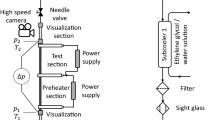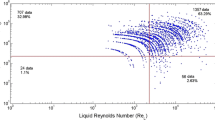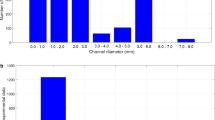Abstract
It is crucial to identify flow regimes/patterns in order to calculate the pressure drop and heat transfer coefficient (HTC) with high accuracy in flow boiling. Researchers have not paid too much attention to the two-phase (2-phase) phenomena and the influence of the 2-phase flow parameters on the performance of absorber tubes. This parametric study sheds the light on some of the well-known and widely used 2-phase flow models/correlations and their impact on absorber performance prediction. The results of 2-phase flow models were compared with experimental data for refrigerants and water to validate these models. Different HTC models are studied. However, the main parameters affecting the absorber tube performance are analyzed and validated. The results showed that for the refrigerant R134a case Wojtan et al. HTC model exhibited the best fit with the experimental data, while in the case of water Shah correlation found to be the best. Moreover, for the pressure drop, Lockhart–Martinelli model showed the best agreement with the experimental data especially at high qualities.


















Similar content being viewed by others
Abbreviations
- \(h\) :
-
Heat transfer coefficient (W/m2 k)
- \(X_{tt}\) :
-
Martinelli parameter (–)
- \(\rho\) :
-
Density (kg/m3)
- \(\sigma\) :
-
Surface tension (N/m)
- \(k\) :
-
Thermal conductivity (W/m k)
- \(C_{p} \) :
-
Heat capacity (J/kg k)
- \(\mu\) :
-
Liquid dynamic viscosity (Pa.s)
- \(T\) :
-
Temperature (°C)
- \(P\) :
-
Pressure (kpa)
- \(v\) :
-
Specific volume (m3/kg)
- \(\gamma\) :
-
Liquid holdup (–)
- \(D\) :
-
Absorber inner diameter (m)
- \(G\) :
-
Mass flux (kg/m2 s)
- \(i\) :
-
Enthalpy (J/kg)
- \({\Delta }P\) :
-
Pressure drop (kpa)
- \(x \) :
-
Vapor quality (–)
- \(h_{{\rm b}} S\) :
-
Bubble formation (W/m2 k)
- \(h_{{\rm L}} F\) :
-
Convection (W/m2 k)
- \(C_{o}\) :
-
Convection number (–)
- \(S \& F\) :
-
Correction and enhancement factors (–)
- \(\phi_{fo}^{2}\) :
-
2-phase multiplier
- \(\phi\) :
-
Friction multiplier
- C:
-
Constant depends on the flow (turbulent or laminar)
- \({\Omega }\) :
-
Correction factor
- \(B_{o}\) :
-
Boiling number (–) \(= \frac{Q}{{h_{fg} \rho V}}\)
- \(\mathrm{Pr}\) :
-
Prantdl number (–) \(= Cp.\mu /k\)
- \(\mathrm{Fr}_{H}\) :
-
Fraud number = \(\frac{{G^{2} }}{{gD\rho_{{\rm h}}^{2} }}\)
- \({ }E\) :
-
\( = \left( {1 - x} \right)^{2} + \frac{{x^{2} \rho_{{\rm L}} f_{GO} }}{{\rho_{G} f_{LO} }} \;{\mathrm{parameter }}\;{\mathrm{in }}\;{\mathrm{Eq}}{.}\;\left( {31} \right)\)
- \(F\) :
-
\(= x^{0.78} \left( {1 - x} \right)^{0.224} , \;{\mathrm{parameter }}\;{\mathrm{in }}\;{\mathrm{Eq}}{.}\;\left( {31} \right)\)
- \(H \) :
-
\( = \left( {\frac{{\rho_{{\rm L}} }}{{\rho_{G} }}} \right)^{0.91} \left( {\frac{{\mu_{G} }}{{\mu_{{\rm L}} }}} \right)^{0.19} \left( {1 - \frac{{\mu_{G} }}{{\mu_{{\rm L}} }}} \right)^{0.7} \;{\mathrm{parameter }}\;{\mathrm{in }}\;{\mathrm{Eq}}{.}\;\left( {31} \right)\)
- \(W{\mathrm{e}}\) :
-
Weber number \(= \frac{{G^{2} D}}{{\sigma \rho_{{\rm h}} }}\)
- \(\rho_{{\rm h}}\) :
-
Homogeneous density = \(\left( {\frac{x}{{\rho_{G} }} + \frac{1 - x}{{\rho_{{\rm L}} }}} \right)^{ - 1}\)
- tp:
-
2-phase flow
- fo:
-
1-phase flow
- g:
-
Gas
- l:
-
Liquid
- b:
-
Nucleate boiling
- tpn:
-
Nucleate boiling is dominant
- bc:
-
Bulk convective
- w:
-
Wall
- sat:
-
Saturation
- h:
-
Homogenous
- Bf:
-
Bankoff
References
Alguacil, M.; Prieto, C.; Rodriguez, A.; Lohr, J.: Direct steam generation in parabolic trough collectors. Energy Procedia 49, 21–29 (2013)
Zarza, E.: Generación Directa de Vapor con Colectores Solares Cilindroparabólicos (2004)
Moreno Quibén, J.; Thome, J.R.: Flow pattern based two-phase frictional pressure drop model for horizontal tubes, part II: new phenomenological model. Int. J. Heat Fluid Flow 28(5), 1060–1072 (2007)
Taitel, Y.; Dukler, A.: A model for predicting flow regime transitions in horizontal and near horizontal gas–liquid ow. AIChE J. 22(1), 47–55 (1976)
Barnea, D.; Shoham, O.; Taitel, Y.; Dukler, A.E.: Gas–liquid flow in inclined tubes: flow pattern transition for upward flow. Chem. Eng. Sci 40, 131–136 (1985)
Hanratty, T.J.: Gas–liquid flow in pipelines. PCH Physicochem. Hydrodyn. 9, 101–114 (1987)
Taitel, Y.: Flow pattern transition in two phase flow. In: Proceeding 91st International Heat Transfer Conference, vol. 1, pp. 237–253. Hemisphere Publishing Corporation, New York (1990)
Odeh, S.D.; Behnia, M.; Morrison, G.L.: Hydrodynamic analysis of direct steam generation solar collectors. Trans. ASME 122, 14–22 (2000)
Sun, J.; Liu, Q.; Hong, H.: Numerical study of parabolic-trough direct steam generation loop in recirculation mode: characteristics, performance and general operation strategy. Energy Convers. Manag. 96, 287–302 (2015)
Baba, Y.D.; Ribeiro, J.X.F.; Aliyu, A.M.; Archibong-Eso, A.; Abubakar, U.D.; Ehinmowo, A.B.: Characteristics of horizontal gas–liquid two-phase flow measurement in a medium-sized pipe using gamma densitometry. Sci. Afr. 10, 1–10 (2020)
Hota, S.K.; Duong, V.; Diaz, G.: Two-phase flow performance prediction for minichannel solar collectors. Heat Mass Transf. Stoffuebertragung 56(1), 109–120 (2020)
Shadloo, M.S.; Rahmat, A.; Karimipour, A.; Wongwises, S.: Estimation of pressure drop of two-phase flow in horizontal long pipes using artificial neural networks. J. Energy Resour. Technol. Trans. ASME 142(11), 112110 (2020)
Sassi, P.; Pallarès, J.; Stiriba, Y.: Visualization and measurement of two-phase flows in horizontal pipelines. Exp. Comput. Multiph. Flow 2(1), 41–51 (2020)
Ghajar, A.J.: Two-phase Gas–Liquid Flow in Pipes with Different Orientations. Springer, Berlin (2020)
Kattan, N.; Thome, J.R.; Favrat, D.: Flow boiling in horizontal tubes: part 1—development of a diabatic two-phase flow pattern map. J. Heat Transf. 120(1), 140–147 (1998)
Zürcher, O.; Favrat, D.; Thome, J.R.: Development of a diabatic two-phase flow pattern map for horizontal flow boiling. Int. J. Heat Mass Transf. 45(2), 291–301 (2001)
Wojtan, L.; Ursenbacher, T.; Thome, J.R.: Investigation of flow boiling in horizontal tubes: part I—a new diabatic two-phase flow pattern map. Int. J. Heat Mass Transf. 48(14), 2955–2969 (2005)
Wojtan, L.; Ursenbacher, T.; Thome, J.R.: Investigation of flow boiling in horizontal tubes: part II—development of a new heat transfer model for stratified-wavy, dryout and mist flow regimes. Int. J. Heat Mass Transf. 48(14), 2970–2985 (2005)
Steiner, D.: Zweiphasen stromung in Apparatenelementen, Hochschulkurs Warmeubertragung II. Forschungs-Ge-sellschaft Verfahrenstechnik e.V., Dusseldorf (1983)
Armand, A.A.: The resistance during the movement of a two-phase system in horizontal pipes (1959)
Kroeger, P.G.; Zuber, N.: An analysis of the effects of various parameters on the average void fractions in subcooled boiling. Int. J. Heat Mass Transf. 11(2), 211–233 (1968)
Rouhani, S.Z.; Axelsson, E.: Calculation of void volume fraction in the subcooled and quality boiling regions. Int. J. Heat Mass Transf. 13(2), 383–393 (1970)
Zhang, H.-Q.; Wang, Q.; Sarica, C.; Brill, J.P.: Unified model for gas–liquid pipe flow via slug dynamics—part 1: model development. J. Energy Resour. Technol. 125(4), 266 (2003)
Barnea, D.: A unified model for predicting transitions for the whole pipe inclinations. Int. J. Multiph. Flow 13(I), 1–12 (1987)
Dengler, J.N.; Addoms, C.E.: Heat transfer mechanism for vaporization of water in a vertical tube. Chem. Eng. 18(52), 95–103 (1956)
Shah, M.M.: Chart correlation for saturated boiling heat transfer: equation and further study. ASHRAE Trans. 88(1), 185–196 (1982)
Kandlikar, S.G.: A general correlation for saturated two-phase flow boiling heat transfer inside horizontal and vertical tubes. J. Heat Transf. 112(1), 219 (1990)
Chen, J.C.: Correlation for boiling heat transfer to saturated fluids in convective flow. Ind. Eng. Chem. Process Des. Dev. 5(3), 322–329 (1966)
Chen, D.L.B.J.C.: Forced convective boiling in vertical tubes for saturated pure components and binary mixtures. Am. Inst. Chem. Eng. 26(3), 454–461 (1980)
Gungor, K.E.; Winterton, R.H.S.: A general correlation for flow boiling in tubes and annuli. Int. J. Heat Mass Transf. 29(3), 351–358 (1986)
Wattelet, J.P., Chato, J.C., Souza, A.L., Christoffersen, B.R.: Evaporative Characteristics of R-134a, MP-39, and R-12 at Low Mass Fluxes Acustar Division of Chrysler Carrier Corporation Ford Motor Company General Electric Company Harrison Division of GM ICI Americas, Inc. Modine Manufacturing Co. Peerless of Ame, vol. 61801, May 1993
Friedel, L.: Improved friction drop correlations for horizontal and vertical two-phase pipe flow. Eur. Two-phase Flow Gr. Meet. Pap. E2, Ispra, Italy (1979)
Lockhart, R.W.; Martinelli, R.C.: Proposed correlation of data for isothermal two-phase, two-component in pipes. Chem. Eng. Process. 45(1), 39–48 (1949)
Chisholm, D.: Pressure gradients due to friction during the flow of evaporating two-phase mixtures in smooth tubes and channels. Int. J. Heat Mass Transf. 16, 347–358 (1973)
Muller-Steinhagen, H.; Heck, K.: A simple friction pressure drop correlation for two-phase flow in pipes. Chem. Eng. Process. 20, 297–308 (1986)
Bankoff, S.G.: A variable density single-fluid model two-phase flow with particular reference to steam-water. J. Heat Transf. 11(Series B), 265–272 (1960)
Cicchitti, R.Z.A.; Lombardi, C.; Silvestri, M.; Soldaini, G.: Two-phase cooling experiments—pressure drop, heat transfer and burnout measurements. Energy Nucl. 7(6), 407–425 (1960)
Baroczy, C.J.: A systematic correlation for two-phase pressure drop. Chem. Eng. Prog. Symp. Ser. 62(44), 232–249 (1966)
Lobón, D.H.; Valenzuela, L.; Baglietto, E.: Modeling the dynamics of the multiphase fluid in the parabolic-trough solar steam generating systems. Energy Convers. Manag. 78, 393–404 (2014)
da Silva Lima, R.J.; Quibén, J.M.; Thome, J.R.: Flow boiling in horizontal smooth tubes: new heat transfer results for R-134a at three saturation temperatures. Appl. Therm. Eng. 29(7), 1289–1298 (2009)
Bang, K.H.; Kim, K.K.; Lee, S.K.; Lee, B.W.: Pressure effect on flow boiling heat transfer of water in minichannels. Int. J. Therm. Sci. 50(3), 280–286 (2011)
Hardik, B.K.; Prabhu, S.V.: Boiling pressure drop and local heat transfer distribution of water in horizontal straight tubes at low pressure. Nanotechnology 27(9), 3505–3515 (2019)
Lobón, D.H.; Baglietto, E.; Valenzuela, L.; Zarza, E.: Modeling direct steam generation in solar collectors with multiphase CFD. Appl. Energy 113, 1338–1348 (2014)
Acknowledgements
The authors would like to acknowledge the Deanship of Scientific Research at King Fahd University of Petroleum & Minerals for their support under Project No. IN171039.
Author information
Authors and Affiliations
Corresponding author
Rights and permissions
About this article
Cite this article
Khalid, K.A., Al-Sarkhi, A. & Bahaidarah, H.M. Influence of the 2-phase Flow Models on Prediction of Absorber Tube Performance. Arab J Sci Eng 46, 2833–2844 (2021). https://doi.org/10.1007/s13369-020-05232-9
Received:
Accepted:
Published:
Issue Date:
DOI: https://doi.org/10.1007/s13369-020-05232-9




